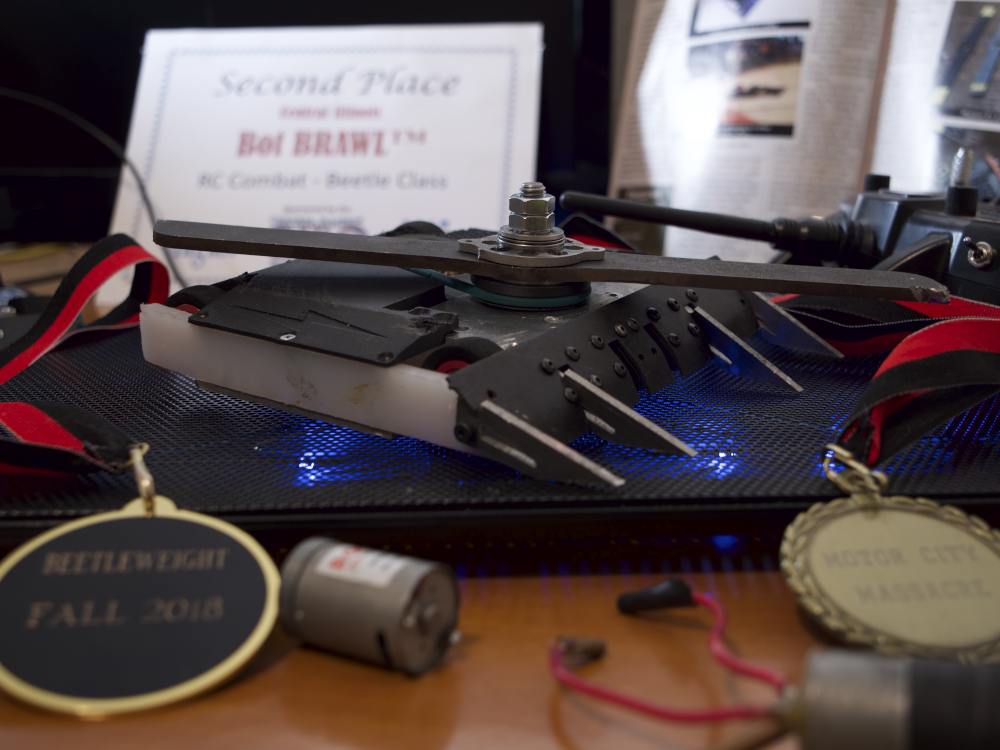Phantom II
Builder: Nik Buchholz
Record: 30-18
Photo Credit: Jacob Conklin
When Phantom II was built in 2017, in addition to seeking redemption from the embarrassment of Phantom I, it was an attempt to make overhead horizontal spinners competitive again in the modern meta of vertical spinners and brick wedges. I took inspiration from bots like Brutality and Icewave, but also drew inspiration from vertical spinners like Bite Force in an attempt to make the bot more controlled and well-rounded.
As with any robot type, overheads have a number of advantages and disadvantages. I started by laying them out on the table.
Advantages:
An overhead bar spinner can benefit from the reach that comes with a very long weapon.
The effective protection that 360-degree weapon coverage provides.
Unlike offset horizontals, an overhead lends itself nicely to the 4-wheel-drive wedge chassis shape, meaning it can take on pushing battles if the weapon dies. This also makes it very maneuverable.
The weapon height allows an overhead to potentially hit above or at the top of an opponent's wedge, or go weapon-to-weapon with vertical spinners. With overcutters being less common than midcutters and undercutters, many opponents are not prepared for this.
An overhead benefits from having a small, dense chassis, which can be stronger and better armored for the same weight as a larger chassis.
Disadvantages:
Unlike offset horizontals, an overhead cannot run inverted, and unlike an FBS, using a pole as a self righter is difficult to implement.
With the chassis being smaller than the weapon, overheads are particularly vulnerable to weapon instability.
Very low opponents can slip underneath the weapon and reach the chassis.
The large weapon can be difficult to spin up, and the 360 weapon exposure makes it very easy for an opponent to interfere with the initial spin up.
In an attempt to min/max the disadvantages/advantages, Phantom II sports the following features:
The weapon is placed toward the front of the robot, maximizing its reach in the forward direction. With a centered weapon, the bot would be protected from verts and steep wedges on all sides, but horizontals and low shallow wedges could potentially reach the chassis before being hit by the weapon. With the forward weapon placement, the chassis is still effectively covered on all sides as far as verts are concerned, but the maximized reach out front allows me to also play "reach-chicken" with lower horizontals or wedges.
The exposed rear wheels, paired with the forward-mounted weapon, allow the bot to drive inverted (albeit, without its weapon). The original hope was to use the drive to self right by ramming the wall, but I figured that movement was better than being immobile in any case.
The weapon is relatively lightweight for a beetleweight horizontal, with the blade only weighing half a pound. The conservative weapon helps the bot avoid major instability most of the time, while still delivering some pretty good hits. This also helps the bot spin up better.
Almost all of the bot's weight is on its 4 wheels, making it quite nimble and able to hold its own in a pushing match.
Interchangeable wedge and wedgelets allow the bot to counter different kinds of opponents.
All in all, Phantom II performed decently throughout the 10 events it competed in, coming away with a lifetime Win-Loss Record of 30-18. Self righting with the drive never quite worked, but in a 2017 fight against k-too, Phantom II did become the first overhead horizontal (to my knowledge) to demonstrate the ability to drive inverted in a fight! Over the three years when it competed, Phantom II also served as a learning platform on which we tested many ideas and learned a lot about the ins and outs of designing and competing with an overhead bar spinner. Many of these experiences informed the design and strategies of Bloodsport! You can see the resemblance in the weapon design, for example. Bloodsport v1 ran with a similar weapon shape to deliver deep cuts while avoiding vertical uppercuts, and the bar was a similar fraction of the total bot weight to try to avoid instability and improve the spin up time.
The original chassis of Phantom II also became Bloodsport's minibot, Thumb War, and saw some action in the BattleBox! Thumb War also served as a test platform for weapon stability, informing the design of Zero Traction v3, and by extension, Bloodsport 2.
Check out the design breakdown and evolution videos for Phantom II Below!
Phantom II’s Weapon compared to Bloodsports Weapon
Phantom II’s original chassis converted into the minibot “Thumb War”, for Season 4 of Battlebots!
Photo credit: Michael Dubicki
Phantom II Design Breakdown!
Phantom II’s Evolution Compilation






